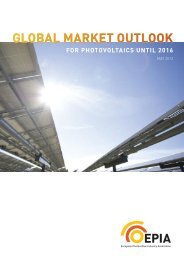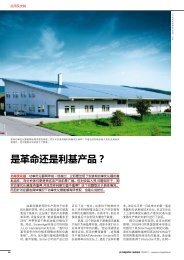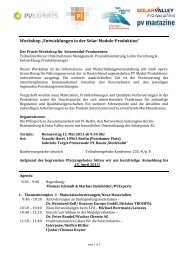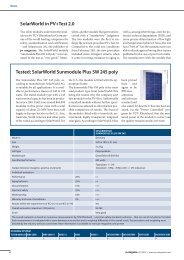Among the best - PV Magazine
Among the best - PV Magazine
Among the best - PV Magazine
Create successful ePaper yourself
Turn your PDF publications into a flip-book with our unique Google optimized e-Paper software.
Applications & Installations<br />
<strong>Among</strong> <strong>the</strong> <strong>best</strong><br />
<strong>PV</strong>+Test: IBC Solar has now subjected its products to <strong>the</strong> challenges of <strong>the</strong> testing<br />
program of TÜV Rheinland and Solarpraxis. The 240 watt monocrystalline module<br />
performed very well in <strong>the</strong> TÜV chambers.<br />
Photo: TÜV Rheinland<br />
The new solar simulator at TÜV Rheinland: measuring <strong>the</strong> performance of modules under standard test conditions.<br />
A crushing vice, a jolt of electricity, blinding<br />
light, high humidity, and merciless<br />
temperatures between -40°C and more<br />
than 80°C – for solar modules, <strong>the</strong> laboratories<br />
at TÜV Rheinland are more<br />
like a modern torture chamber. The testing<br />
procedure has pushed some modules<br />
Test: IBC Monosol 240 ET<br />
IBC Solar’s Monosol 240 ET is available in five different<br />
performance classes; from 230 to 250 watts. The module<br />
contains 60 Bosch solar cells and is built for IBC Solar by Solarwatt<br />
in Dresden. IBC controls <strong>the</strong> quality of <strong>the</strong> modules<br />
according to its own standard through regular audits and<br />
quality control inspection. According to <strong>the</strong> manufacturer,<br />
<strong>the</strong> modules are ideally suited for use on single-family<br />
homes whose owners care about <strong>the</strong> good looks and<br />
efficient use of <strong>the</strong>ir roofs. They are also installed on commercial<br />
buildings and industrial roofs.<br />
The module has been on <strong>the</strong> market since 2007 and is now<br />
certified for all of <strong>the</strong> European markets. Since it began<br />
selling <strong>the</strong>m, IBC says that it has sold some 300,000 units<br />
of this module type. Hollow chamber aluminum frames<br />
ensure <strong>the</strong> stability of <strong>the</strong> panels. Their resistance to ammonia<br />
and saltwater makes <strong>the</strong> modules well-suited for use<br />
in agricultural or coastal applications.<br />
past <strong>the</strong>ir limits. But <strong>the</strong> ones who make<br />
it through are among <strong>the</strong> <strong>best</strong> of <strong>the</strong> <strong>best</strong>.<br />
With 89.8 total points and an overall rating<br />
of “good +”, <strong>the</strong> IBC Monosol 240 ET<br />
is now a member of that class.<br />
As can be expected from a module with<br />
a “good +” rating, <strong>the</strong>re was not much<br />
Photo: IBC Solar<br />
to complain about. To <strong>the</strong> contrary, all<br />
five of <strong>the</strong> modules purchased by mystery<br />
shoppers on <strong>the</strong> open market far exceeded<br />
<strong>the</strong> performance data provided by<br />
<strong>the</strong> manufacturer – by an average of 1.2<br />
watts. This attested to <strong>the</strong> manufacturer’s<br />
positive sorting claim. The module<br />
is also very well made. The TÜV testers<br />
searched in vain for sharp edges, foreign<br />
material inclusions or bubbles. An examination<br />
using electroluminescence imagery<br />
found no faults ei<strong>the</strong>r.<br />
The load tests too were uneventful for<br />
<strong>the</strong> most part. The testing regime includes<br />
a <strong>the</strong>rmal cycling test, two damp<br />
heat tests, and two mechanical load tests,<br />
parts of which far exceed <strong>the</strong> standards<br />
for <strong>PV</strong> modules. After testing, <strong>the</strong> IBC<br />
Monosol 240 ET panels that underwent<br />
<strong>the</strong> tests showed no significant outward<br />
signs of damage. In only one case, a few<br />
bubbles formed on <strong>the</strong> product label of<br />
one of <strong>the</strong> modules. The relative performance<br />
degradation after testing was also<br />
ra<strong>the</strong>r slight. The greatest damage was apparent<br />
after <strong>the</strong> first mechanical load test<br />
with 2,400 pascals. After that test, relative<br />
96<br />
04 / 2012 | www.pv-magazine.com
Applications & Installations<br />
performance degradation was measured<br />
at a mere -0.81 percent. Many of <strong>the</strong> o<strong>the</strong>r<br />
modules previously tested at <strong>the</strong> facility<br />
showed a higher degree of performance<br />
degradation. In <strong>the</strong> worst case, following<br />
a mechanical load of 2,400 pascals, one<br />
of <strong>the</strong>se o<strong>the</strong>r modules dropped 4.3 percentage<br />
points.<br />
Low resistance<br />
A few small faults had to be overcome,<br />
however. One of <strong>the</strong> areas where <strong>the</strong> module<br />
lost points was insulation resistance.<br />
The initial value of 23 gigaohms square<br />
meter was not bad, but after <strong>the</strong> 1000 hour<br />
damp heat test, <strong>the</strong> value plummeted to<br />
200 megaohms square meter (MΩ∙m²).<br />
Because <strong>the</strong> final value was more than<br />
50 percent lower than <strong>the</strong> initial measurement,<br />
<strong>the</strong> module was docked three<br />
points. An insulation resistance of 200<br />
MΩ∙m² is still acceptable according to <strong>the</strong><br />
requirements of <strong>the</strong> product standard,<br />
which stipulates a limit of 40 MΩ∙m².<br />
That is <strong>the</strong> minimum requirement, however.<br />
<strong>PV</strong>+Test sets <strong>the</strong> bar higher.<br />
Andreas Cox, who is responsible for<br />
photovoltaic module qualification and<br />
for <strong>PV</strong>+Test at TÜV Rheinland, explains<br />
why: “While evaluating <strong>PV</strong> systems, we<br />
found cases where central inverters sometimes<br />
shut <strong>the</strong>mselves down as a result of<br />
low insulation resistance.”<br />
That can happen, for instance, when<br />
modules with a low insulation resistance<br />
are exposed to dew in <strong>the</strong> morning. When<br />
that happens, <strong>the</strong> weakest module in <strong>the</strong><br />
string determines what happens next. “If<br />
<strong>the</strong> insulation resistance of <strong>the</strong> modules<br />
<strong>PV</strong>+Test: List of <strong>the</strong> <strong>best</strong> modules<br />
Scoring system – Modules tested: 13<br />
drops dramatically as a result of exposure<br />
to moisture, as we simulate in <strong>the</strong><br />
damp heat test, it is taken into account<br />
in <strong>the</strong> evaluation,” Cox explains, “Even if<br />
<strong>the</strong> absolute value still meets <strong>the</strong> requirements<br />
of <strong>the</strong> standard and despite <strong>the</strong> fact<br />
that <strong>the</strong> effect can be reversible.”<br />
Reduced insulation values following<br />
<strong>the</strong> damp heat test are nothing new for<br />
<strong>the</strong> TÜV testers. The standard specifies<br />
a measurement window of two to four<br />
Ranking Points Score Manufacturer Module type<br />
1 94.3 excellent Solon Solon Blue 230/07-235W<br />
2 91.3 excellent (-) Schott Solar Schott Poly 290<br />
3 90.7 excellent (-) Sharp NU-180E1<br />
4 89.8 good (+) IBC Solar IBC Monosol 240 ET<br />
5 89 good (+) Mitsubishi Electric <strong>PV</strong>-TD185MF5<br />
6 88.1 good (+) Conergy PowerPlus 225P<br />
7 84.3 good Sovello SV-X-195-fa1<br />
8 80 good (-) Perfect Solar PS230-6P-TOP<br />
excellent excellent (-) good (+) good good (-) satisfactory (+) satisfactory poor very poor<br />
1 3 4 2 1 0 1 1 0<br />
Advertisement<br />
<strong>PV</strong> Conferences 2012<br />
Top marketing for your brand to <strong>the</strong> sector<br />
<strong>PV</strong> Project India 2012 | September 2012, India<br />
<strong>PV</strong> Technology Conference – North Africa 2012 | September 2012, Casablanca, Morocco<br />
Quality for Photovoltaics 2012 | 6 September 2012, Berlin, Germany<br />
Solar meets Glass – 3 rd Industry Summit for Production, Logistics and Technology |<br />
October 2012, Düsseldorf, Germany<br />
Conferencia de la Industria Solar – España 2012 | October 2012, Spain<br />
Solar Industry Summit – Middle East 2012 | 13 – 14 November 2012, Dubai, United Arab Emirates<br />
13 th Forum Solarpraxis | 22 – 23 November 2012, Berlin, Germany<br />
<strong>PV</strong> Power Plants – USA 2012 | 28 – 29 November 2012, Phoenix, USA<br />
www.solarpraxis.com
Applications & Installations<br />
<strong>PV</strong>+Test results<br />
Made in<br />
Size (millimeters)<br />
Weight<br />
Cell type<br />
Module type<br />
Performance parameters<br />
Specified power<br />
IBC Solar<br />
IBC Monosol 240 ET<br />
Germany (OEM: Solarwatt)<br />
1,680 mm x 990 mm x 50 mm<br />
24.0 kg<br />
monocrystalline 6’’ cells<br />
Glass/EVA/cell/EVA/foil<br />
240 watts<br />
Output tolerance (negative / positive, in percent) 0/+2.1<br />
Deviation of measured performance from specified performance +1.21<br />
Measured performance within <strong>the</strong> specified performance tolerance<br />
Efficiency under STC (1000 watts of solar radiation per m 2 , 25 °C, measured) 14.5<br />
Efficiency reduction at low light levels (200 watts of solar radiation per m 2 ) -2.5<br />
Temperature coefficient (percent) -0.465<br />
Efficiency reduction at 50 degrees (temperature coefficient measured) -11.63<br />
Fill factor 76.2<br />
Evaluation of performance variance +++<br />
Evaluation of low-light behavior +<br />
Evaluation of temperature behavior -<br />
Evaluation performance parameters (20%) ++<br />
Aging behavior<br />
Thermal cycling test (power degradation in percent) -0.38<br />
Damp heat test, 1000 h (power degradation in percent) 1.3<br />
Damp heat test, 1500 h (power degradation in percent) 0.0<br />
Mechanical load test, 2400 Pascal (power degradation in percent) -0.8<br />
Mechanical load test, 5400 Pascal (power degradation in percent) -0.5<br />
Evaluation of <strong>the</strong> <strong>the</strong>rmal cycling test ++<br />
Evaluation of <strong>the</strong> damp heat test, 1000h +<br />
Evaluation of <strong>the</strong> damp heat test, 1500h +++<br />
Evaluation of <strong>the</strong> mechanical load test (2400 pascals) +++<br />
Evaluation of <strong>the</strong> mechanical load test, very high load (5400 pascals) +++<br />
Irregularities<br />
Evaluation aging behavior (25%) ++<br />
Documentation<br />
IEC 61215/IEC 61730/CE label +/+/+<br />
Irregularities<br />
Evaluation documentation (15%) +++<br />
Electrical safety<br />
Results meet requirements of safety standard IEC 61730<br />
Irregularities<br />
Yes<br />
Bubbles on <strong>the</strong> product label after <strong>the</strong> damp heat test<br />
Information on materials, deviations P max , and protection<br />
class were insufficient; instructions for grounding were<br />
inadequate.<br />
Yes<br />
None<br />
Evaluation electrical safety (25%) +++<br />
Processing<br />
Sharp edges (test according to UL)<br />
Visible irregularities<br />
None<br />
Electroluminescence +++<br />
Evaluation processing (10%) +++<br />
Warranty and ease of installation<br />
Product warranty<br />
Performance guarantee 90% / 80%<br />
Irregularities<br />
Comments<br />
Partly overlaying adhesive frame tapes, soldering was not<br />
always perfect.<br />
10 years<br />
Evaluation warranty and ease of installation (5%) +++<br />
Overall evaluation<br />
Results within <strong>the</strong> requirements of IEC 61215 and IEC 61730<br />
Overall evaluation (maximum 100 points) 89.8<br />
12 years/25 years<br />
Score good (+)<br />
Installation, dismantling, and transport are not covered.<br />
Relatively heavy (24 kg)<br />
Yes<br />
hours after <strong>the</strong> conclusion of <strong>the</strong> test because<br />
moisture can diffuse back out of <strong>the</strong><br />
modules over time. That was also <strong>the</strong> case<br />
with <strong>the</strong> IBC module. Subsequent measurements<br />
showed that <strong>the</strong> insulation<br />
value had returned to normal.<br />
The precise point at which inverters<br />
switch off varies from manufacturer to<br />
manufacturer. Fur<strong>the</strong>rmore, <strong>the</strong> overall<br />
concept of a photovoltaic system and <strong>the</strong><br />
size of <strong>the</strong> solar generator also determine<br />
<strong>the</strong> resulting insulation resistance for <strong>the</strong><br />
system. Thus, <strong>the</strong> module is only one of a<br />
number of possible factors.<br />
“That is why <strong>PV</strong>+Test generally gives<br />
higher evaluations to modules with<br />
higher resistance,” says Cox. Never<strong>the</strong>less,<br />
at no time during <strong>the</strong> testing procedure<br />
did <strong>the</strong> IBC modules ever show<br />
a worrying insulation value. If that were<br />
<strong>the</strong> case, <strong>PV</strong>+Test would have drastically<br />
lowered <strong>the</strong> overall score.<br />
“The IBC modules merely showed<br />
a strong relative decline which cost it<br />
three points in <strong>the</strong> individual category,”<br />
Cox said.<br />
Documentation problem addressed<br />
The module also lost points in a subevaluation<br />
due to occasional imprecision<br />
in <strong>the</strong> technical documentation. At<br />
<strong>the</strong> time <strong>the</strong> tests were performed, some<br />
data about <strong>the</strong> materials used in <strong>the</strong> modules,<br />
potential deviations from <strong>the</strong> nominal<br />
output, and information about <strong>the</strong><br />
protection class were missing. Fur<strong>the</strong>rmore,<br />
as is <strong>the</strong> case with many o<strong>the</strong>r<br />
manufacturers, instructions for grounding<br />
<strong>the</strong> modules were inadequate. In <strong>the</strong><br />
interim, IBC Solar has responded and has<br />
revised both <strong>the</strong> product specification<br />
sheet and <strong>the</strong> installation instructions,<br />
and now <strong>the</strong> documentation is comprehensive.<br />
u<br />
Mirco Sieg<br />
Overview and contact<br />
Every measurement is assigned a score<br />
of between zero and ten points which<br />
is weighted and incorporated into <strong>the</strong><br />
overall score. The table does not contain<br />
all of <strong>the</strong> measurements underlying <strong>the</strong><br />
overall score. You’ll find a detailed description<br />
and all of <strong>the</strong> <strong>PV</strong>+Test results at:<br />
www.pv-magazine.com/pv-test<br />
<strong>PV</strong>+Test is a registered trademark.<br />
The table may only be reproduced or<br />
distributed with <strong>the</strong> express consent of<br />
Solarpraxis AG and TÜV Rheinland.<br />
98<br />
04 / 2012 | www.pv-magazine.com

















